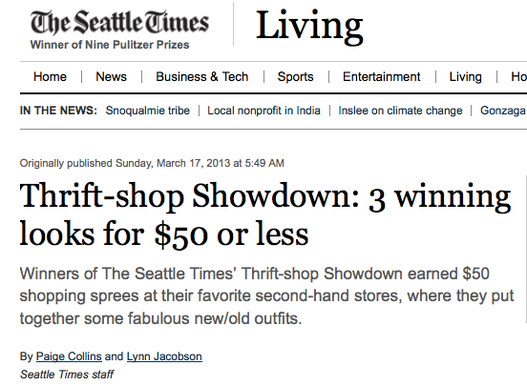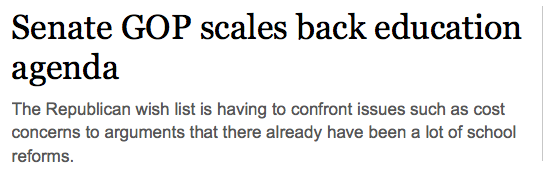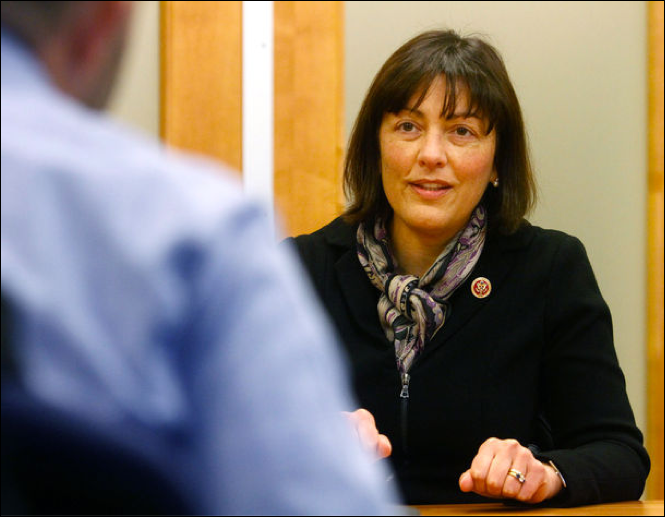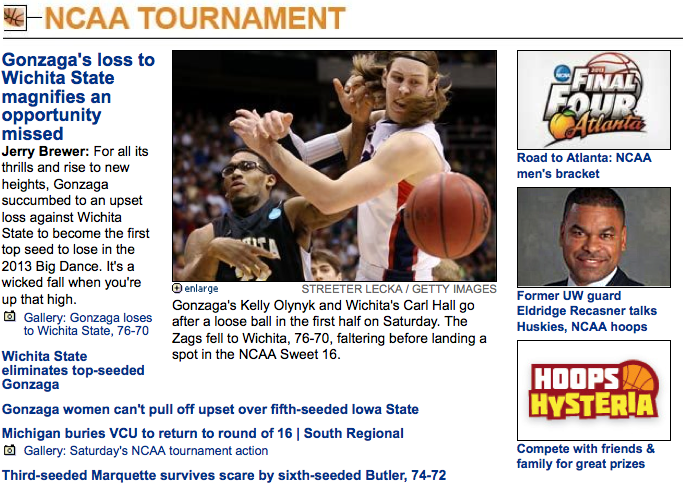Well this one throws me for a loop. I'm supposed to write about religion for this week's post. It is the day of Jesus' rising from the dead, and the week of Passover. A Big deal in the religious community. So one would think that a time honored news organization like The Seattle Times would be vast in their coverage of such an important yearly event. Not so. According to the website city-data.com, 37.2% of King County is Christian. Of that percentage, more than 86% affiliates themselves as Christian. This is a significant portion of the King County community that "cares" or has a vested interest in Easter.Yet, The Times only has a few religious articles on its website .In fact, the most prominent "Easter Related" article had to do with a peep sculpture competition. While the competition has some brilliant pieces – see "peep impact" in the slideshow above, a play on the 1998 film Deep Impact staring Robert Duvall and Tea Leoni – the article is useless as far as religious articles go. There were some cool religious articles posted on the website. There was one associated press piece about Christians in the Middle East that was posted today. Again, the coverage was not totally lacking, just totally lack from The Times' reporters. The top three articles on the site on Sunday had nothing to do with eater at all, though. The top article was about a former sex-offender who had been accused of rape. The number two article was bout the potential trade of the Seahawks' Matt Flynn to Oakland. Nothing stops the football machine. The Third is about an event that could lead to NBA basketball returning to the emerald city, a story that has more than just sports implications. The Times is a great paper, but they didn't cover Easter for some reason, even in a market that theoretically demands it. The only explanation is that their local beat writers chose not o cover a story they had in the past, and chose to cover something else. I have no problem with this in and of itself, but it does make it difficult to cover re
I have been very critical of The Seattle Times in the past for its coverage of national stories. Actually, I have applauded them for using wire coverage rather than wasting resources on stories where they can't compete. The NCAA tournament is certainly a national story, but their coverage has been excellent thus far. Most of their coverage has focused around Gonzaga. On Thursday night they had a very good article about the near upset that the Zags had against 16 seeded Southern. Gonzaga, a Jesuit school from the other side of Cascade Mountains in Spokane, Washington. Even though the school is far away from Seattle, its recent basketball success has made it a favorite among Pacific Northwest college basketball fans, and thus a coverage favorite. The school also locked down its first 1 seed in the NCAA tournament. It is also the highest seeding for a team from the state of Washington since the University of Washington– colloquially known as U-Dub – was a 1 seed in the 2005 NCAA tournament. Unfortunately for Gonzaga fans, people from Washington, and anyone who had the Zags going far in the tournament, the Zags lost to mighty Wichita State on Saturday. Bud Withers had a great lede in his story about the loss yesterday. Actually most of Wither's writing ha been excellent thus far in the tournament. Mr. Withers stories withstanding, The Times coverage has had its faults. I talked in my last post about their use of video, or lack thereof. Those faults have continued, despite the criticism's of this world renowned media critic. It draws me away from the story I am reading every time I go and click on a video. Very frustrating. They also have not had their own writers covering the other games. They have had AP stories on other big games, though. I would be remiss if i wrote a blog post about college basketball and didn't mention Marquette University advancing to the Sweet 16 for a third year in a row with their win over Butler. All problems aside I have really enjoyed The Times' coverage of the tourney this year. It has been well put together, and like any other Times coverage of an event, the writing has been excellent. It seems to me that the Times writers really pride themselves on their prose. As a journalist that makes me very fond of them.
 The Times did not attach the video they have for this story on the same page. In my media critiques of The Seattle Times I have found very few things to complain about. Unfortunately that streak has to come to an end. When it comes to how the Times uses video, there is a lot to be desired. I'm not saying that they don't have good video, because they do. The problem is, there just isn't enough of it. As one of the many young news consumers who get all of their news online, I'm used to having a lot of multimedia attached to he stories I am interested in. And not just video. I want graphs, image galleries and links to other stories. The Times is lacking in all of these areas. My favorite news sights – The Washington Post's Wonkblog and Buzzfeed's Politics section for politics, ESPN for sports – all excel in providing multimedia content to supplement their news coverage. The Times rarely attaches video to stories When they do, its not on the story page but linked to a separate page, illustrated perfectly in their thrift-shop fashion story. (On that note, it goes to show just how scarce video is on their sight if I'm reading a fashion story) While it is frustrating not having the video or other multimedia available to supplement a story, I was never dissapointed in the video i did find. One video in particular, a profile on musician Eyvind King, is among the best I've seen of its kind. interesting and beautifully crafted, it tells a story in an interesting way. Of course, even it is not without faults. The problem lies in the lack of a written story to go with it. When I wanted to find out more on the main character, I had to go searching the internet off sight. I have talked a lot about market trends on this blog before and how The Times is doing a good job of carving out a piece of the market for themselves to subsist in. I'm going to talk about market trends more now, but with the opposite theme. for any news organization to be successful in the internet age they are going to have to diversify their media presentation. This includes presenting the same written story with different forms of multimedia. It keeps readers interested, which keeps news sources relevant. The Times has been making all the right moves, except in this area. I think The Times will get the message soon. They have to. As editors start to see the traffic statistics on their site and understand what these numbers mean, they will change. The Times is not very good. But the amazing thing is that they could be great with only a few small changes. Attach more video on the same page as stories, and attach stories to all produced video. Its a simple formula, and one that The Times needs to figure out.
 The Seattle Times state government legislative recap focused on major education reform Anyone who knows me knows that education is one of my major issues. Public education has been called everything from a "failed experiment" to the "silver bullet." I have written in the past about how it is an issue that remains vitally important but doesn't get covered in the way that it should. While I am happy that Brian Rosenthal is writing about the issue, I am disappointed that The Seattle Times's writer is perpetuating the failed style that has plagued education journalism for so many years. First, a little background on the issue. The Republican Party controls the education committee in the Washington legislature. This is a major victory for the party to control an important committee in what is known to be a very liberal section of the country. The GOP, who recently proposed large scale education reforms in the state, is now drastically altering their reforms under pressure of opposition from unions, and from withing their own party. Without going on to much of a rant, it is worth noting that this type of action is common on education reform bills across the country, regardless of the proponent party. While this is a story that is important to cover, it is indicative of the type of journalism that fails to help improve the state of public education in this country. As the famous Washington D.C. think-tank the Brookings Institution noted in their 2009 report on education reform, one of the great problems with education reform is that not many people understand the complex issues facing education. Furthermore, those who are supposed to educate the public on the issues, journalists, fail to do an adequate job. Brookings noted that in the first nine months of 2009, only 1.4 % of all published journalism pieces dealt with education. And of those pieces, the majority did not attempt to address education issues, but rather focused on the economic and political issues surrounding reform. Journalists have a distinct ability to bring complex social issues to the masses in a simplified understandable way. Because we have that ability we have the responsibility to do this. When it comes to education, however, we fail to address the problems with education in our areas and prefer to focus on the easier to report angles of politics, crime and money. While I am very pleased that Rosenthal is reporting this issue at all, it remains one of theses articles that will only point out that there is problems in education. If that is all you accomplish then the story is no long that important. We all know there are problems with public education, but very few of us can actually point out what they are. While this story needs to be reported, it does not accomplish anything other than proving that there are political challenges in the Washington legislature in regards to education. I would like to see a story like this paired with a story that address specific problems in Washington schools.

Rep. Suzan DelBene. Photo courtesy Greg Gilbert / The Seattle Times
Rep. Suzan DelBene made her fortune working for Microsoft in the early '90s as a marketing director. Her Husband is a Microsoft executive. Now the two term representative from Medina is facing a serious conflict of interest in her role on the judiciary committee as it relates to immigration reform, a topic that is very important to the the Washington based technology giant. The Seattle Times' D.C. bureau chief Kyung M. Song did an excellent job of bringing this issue to light. Immigration reform has been set up to be the major issue of the first half of Barack Obama's second term as president. He announced early in his first term that immigration reform would be the next big issue he would try and tackle after he passed health care reform, but was not able to get it done in the fist term. In this year's State of the Union address he announced it would be the first major issue he would approach. Outside of the Sequester, this is the biggest issue facing congress right now. In her role on the Judiciary committee, DelBene holds a great amount of influence over what bill will make it out of committee hearings on the subject. This constitutes a significant conflict of interest for her as her former employer is one of the biggest supporters of immigration reform. Technology companies like Microsoft are constantly searching China and India where they can find highly educated, highly intelligent young minds to come work for them at a cheaper rate than their American counterparts. The problem is that it is not always easy to get these folks visas to come work in the U.S. Kyung does a good of of attacking this potential conflict of interest directly while presenting the issue fairly. As journalists we deal with these ethical questions on a daily basis. Anyone who follow politics to any degree understands the ethical questions that face lawmakers are very similar. If you are to close to a subject how can you be fair is your work towards it? I was drawn to this article for these reasons and appreciate Kyong's ability to navigate the rough waters of an issue like this while still creating a narrative that tells the whole story. It is a difficult task, even though he is reporting the issue not living it. I do have a few complaints about Kyung's piece. I dislike how he breaks up the article into sections. I can understand how that is effective in telling the different aspects of the story, but I have never like that tool. I prefer to read my stories as one single flow of storytelling. When he breaks up the article to tell the story in pieces it becomes distracting to me.
|




 RSS Feed
RSS Feed